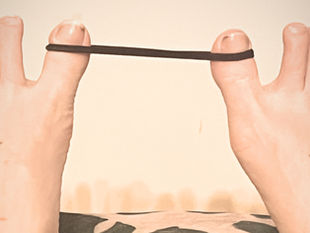
Rooted in Pain: The Coccyx & Fibromyalgia Connection
0
7
0
Have you ever felt that deep ache right at the tailbone, the kind that makes sitting feel impossible? If you live with fibromyalgia, you’re not imagining it. That sharp, bruised feeling at the base of the spine (the coccyx) is more common than people realise, and often overlooked.
Recently, I noticed mine flaring too, just after I’d slightly changed my sitting setup. That small tweak was enough to throw everything out of alignment. It made me realise how fibro pain doesn’t always start where it hurts, sometimes it’s a chain reaction of tension, nerves, and energy imbalance.
One of my friends has suffered with this kind of pain for years. I know she’s been diagnosed with something else but imagine if it’s actually fibro. I didn’t know I had fibromyalgia for two reasons: ten years on Zoloft masked the pain a little, and I’d lived with back pain since I was a teenager after first damaging my spine. I also have scoliosis, so my doctor always said it made sense that I’d have pain, one side of the spine being pulled, the other pushed, with muscles and bone twisted into positions they weren’t designed for.
When I complained to a doctor about my hand pain, she dismissed it as arthritis, saying, “everyone has that.” She sent me for an x-ray and blood tests, and of course, it wasn’t arthritis. It took a specialist less than five minutes to confirm it was fibro. Thank goodness fibromyalgia medication takes away about 70% of the pain, but not the coccyx. It makes me wonder how many people, especially women, are being told their pain is “normal” when it’s not.

Could I Have Fibro?
It’s surprisingly common for fibromyalgia to go undiagnosed for years, especially in women. Many are told their pain is due to stress, hormones, arthritis, or “just getting older.” But fibro has a distinct pattern that sets it apart once you know what to look for.
Here are some of the tell-tale signs:
Widespread, shifting pain: It’s rarely in just one place, neck, back, hips, or even hands and feet can flare without clear reason.
Morning stiffness or bruised feeling: Like you’ve run a marathon in your sleep.
Unrefreshing sleep: You can sleep for 10–12 hours and still wake up exhausted.
Cognitive fog (“fibro fog”): Forgetting words, losing focus mid-conversation, or zoning out mentally.
Sensitivity overload: Bright lights, loud noises, certain fabrics, or even hugs can suddenly feel overwhelming.
Temperature dysregulation: You’re too hot or too cold, sometimes in the same hour.
Digestive troubles: IBS-like symptoms, bloating, or food sensitivities often go hand in hand.
Emotional intensity: Anxiety, depression, or emotional swings that feel amplified because your nervous system is already on high alert.
Painful touch: If light massage on your arms and legs hurts far more than it should, or if a massage chair that works on your calves feels like it’s pressing so hard your legs might split open, that’s a huge clue. Fibro pain often shows up as oversensitivity to touch or pressure, even when it seems gentle to others.
Many people mistake fibro for arthritis, chronic fatigue, or even just “being run down.” The truth is, fibro isn’t in your head, it’s in your nerves. Your body’s pain signals are turned up far too high, and instead of switching off, they loop.
If this sounds familiar, it’s worth asking your doctor for a referral to a rheumatologist or pain specialist who understands fibromyalgia. A proper diagnosis can change your life, not only for pain relief, but for finally feeling validated.
The Physical Layer
Your coccyx (tailbone) is a delicate structure designed to move just a little when you sit, stand, or bend. When posture shifts, even slightly, it can:
Pull on surrounding muscles and fascia (especially the pelvic floor and lower back)
Trigger inflammation or nerve sensitivity
Compress already overactive fibro nerves
Fibromyalgia heightens nerve sensitivity, so what might be a minor misalignment for others can feel intense and constant for you. Hard chairs, sitting unevenly, or long car rides can all amplify this pain loop.
Common Everyday Triggers
Sitting on a surface that slopes or tilts your pelvis
Crossing your legs for long periods
Poor lumbar support or uneven weight distribution
Tight hips or glutes from lack of movement
A new chair, cushion, or work setup
I’d recently changed how I sat, just a little, and boom, the pain began. When I returned to better posture, the relief was instant. It showed how tiny mechanical shifts can affect fibro’s tender nervous system.
Grounding the Fix
Here’s what can help both physically and energetically:
Postural Rebalance: Sit evenly on both sit-bones; use a donut or wedge cushion to lift pressure off the coccyx.
Movement Micro-Breaks: Every 20–30 minutes, stand, stretch, or walk for a minute to release fascia tension.
Warmth Therapy: Apply heat packs to the lower spine and sacrum. Warmth helps fibro nerves calm down.
Gentle Stretches: Try glute, piriformis, and hip opener stretches daily.
Root Chakra Reconnection: Visualise red energy glowing from the base of your spine down to your feet. Breathe in stability, exhale pain, you’re re-grounding your energy into the Earth.
The SciWoo Perspective
In energy terms, the coccyx aligns with the Root Chakra, the foundation of security, grounding, and belonging. When that base is thrown off physically, it can ripple emotionally, creating feelings of instability, worry, or even disconnection from your body. Fibromyalgia already heightens energetic sensitivity, so when the coccyx misaligns, it can feel like your whole base frequency wobbles. Realigning posture, grounding through meditation, or even visualising yourself anchored to the Earth helps restore both physical comfort and energetic safety.
Closing Thought
Pain is often the body’s way of whispering: “You’ve shifted out of alignment, come back home.”
When we listen early, the body responds kindly.
Whether you approach it through anatomy, energy, or both, your coccyx is asking for balance, not just in how you sit, but in how you root yourself in the world. -Ang x








